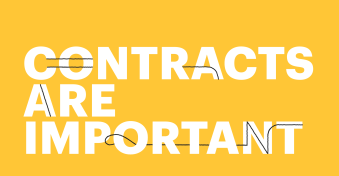Are you kicking off a real estate business, starting your freelance career, working in sales, or any other field where contracts are key?
In this guide, we’ll break down the different types of contracts you might use and explain the aspects of contract law you need to know.
You’ll also learn how to easily draft your first and all subsequent contracts with the help of customizable business templates.
Let’s master contract creation!
What is a contract?
A contract is a legally binding agreement between two or more parties. In it, you have all the details of the agreement clearly defined.
Think of it as a legally enforceable promise, with parties saying to each other, “I will do this, and if I don’t, you can take these legal steps to seek a remedy.”
A contract also explains the responsibilities of each party and the legal consequences that may occur if you or any other party breaks the contract terms.
What makes a contract legally binding?
In order for a contract to be legally binding, it must meet certain requirements.
Specifics may vary by jurisdiction but generally include seven essential elements.
These are:
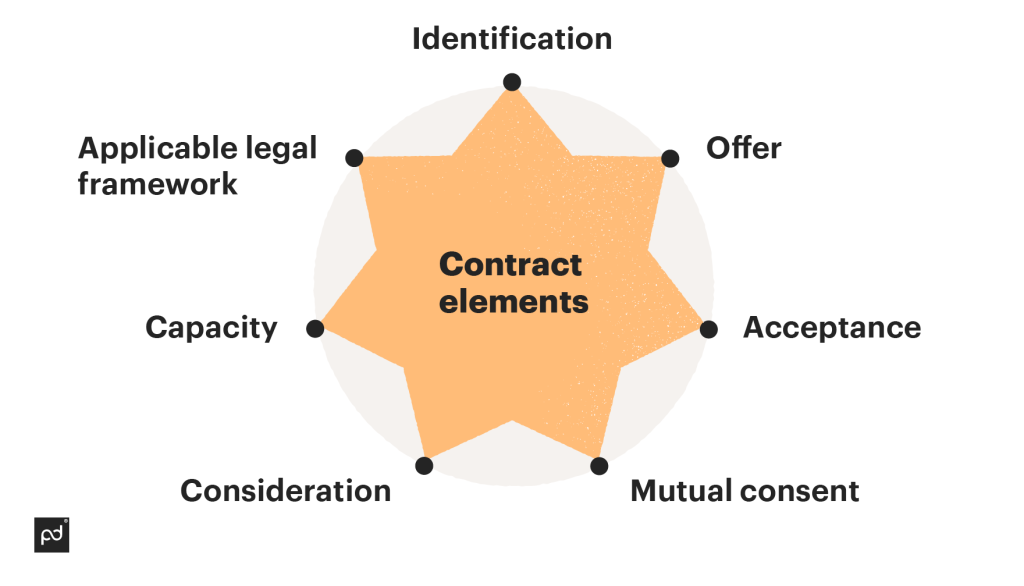
- Identification. Clearly define all the parties involved.
- Offer. What one party promises to the other party in exchange for something in return.
- Acceptance. Approval of the contract, a “yes” from all sides.
- Mutual consent. Everyone involved shows their consent by signing the contract.
- Consideration. The consideration is about what each party gains.
- Capacity. Everyone signing needs to be legally and mentally competent to do so.
- Applicable legal framework. Last but not least, the contract must align with local laws, for example, state laws, to be legit.
These seven parts of the contract allow you to turn a simple promise into a legally binding contract.
What are the 5 essential elements of a contract?
We covered what makes a contract legally binding above, but contracts must include these essential elements:
- Offer: One party proposes an agreement, outlining specific terms.
- Acceptance: The other party agrees to the terms, creating mutual consent.
- Consideration: Something of value (money, services, goods) is exchanged between the parties.
- Legal capacity: All parties must be of legal age and sound mind to enter into the agreement.
- Legal purpose: The contract’s terms must comply with applicable laws and not involve any illegal activities.
These key components ensure clarity, fairness, and legal enforceability, protecting all parties involved in the agreement.
What are the most common types of contracts?
Contracts are everywhere, from our mortgages to our phone plans.
Creating an exhaustive list of types of contracts would take many pages. Instead, here are the most common contract types you’ll see in day-to-day business:
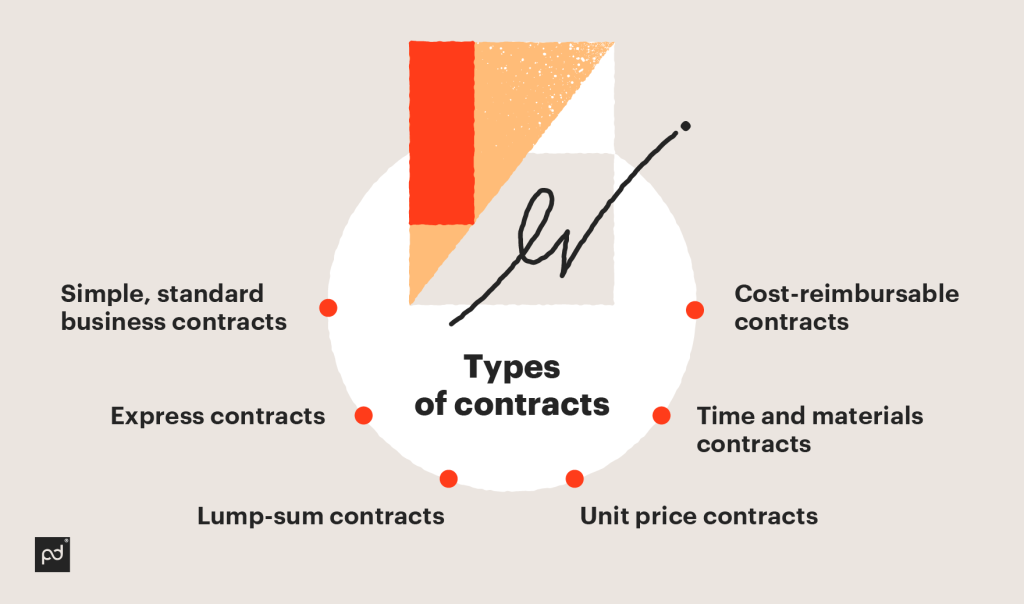
1. Simple, standard business contracts
This type of contract is a simple outline of an agreement between two parties.
For example, a non-disclosure agreement (NDA) or an employment contract between an employee and a business owner.
It’s legally binding and enforceable, even though it doesn’t require an official seal.
These kinds of contracts can be verbal agreements, although written contracts are always advised.
Verbal contracts can be difficult to enforce when disputes arise.
2. Express contracts
An express contract occurs when two or more parties interact and agree on terms.
For example, if you’re at an auction and you bid on an item, you form an express contract to buy that item.
There doesn’t need to be a written agreement for this to happen.
3. Lump-sum contracts
Also known as a fixed-cost contract, parties agree to a lump-sum payment in advance.
For example, an agreement to pay an independent contractor’s estimate.
There’s usually a consideration for unexpected costs built into the payment.
That’s because the payment details stay the same even if costs increase during work.
Cost estimation can be a lengthy process with these contracts. It’s important for estimates to be accurate to avoid one party losing out on the deal.
4. Unit price contracts
In these legally binding contracts, the price of a “unit” is mutually agreed upon by a buyer and a provider.
A unit can represent time, materials, or labor. For example, one unit might be the cost to complete one square foot of flooring.
Therefore, the total cost of the contract is only determined once the work is completed.
Total costs can be estimated based on the scale of the project.
That means it’s easy for both parties to understand and adjust in case of a change of scope.
5. Time and materials contracts
This one is quite self-explanatory; payment is based on the time and materials needed to complete a project.
This is a highly flexible form of legal agreement, but it can lead to escalating costs if project parameters change.
6. Cost-reimbursable contracts
A contractor is reimbursed for the costs incurred over the terms of the contract.
This is normally estimated by the contractor before work is completed. Parties can also agree on a cost ceiling to avoid costs going beyond a certain point.
This is quite common for lawyers or legal advice.
These kinds of service contracts allow for ongoing work with a contingency. Parties can meet and discuss the next steps if the cost ceiling is reached.
How do I create a contract in simple steps?
You can create a contract agreement from scratch or with the help of contract management software and use a document tracking solution to track all the actions that parties involved take.
Either way, follow these simple steps.
1. Discuss contract details with all parties
Before you start creating your contract, meet with all parties to ensure everyone understands the expectations, responsibilities, and purpose of the agreement.
2. Choose the right type of contract
Select the appropriate type of contract —such as service agreements, NDAs, or sales contracts—based on the details discussed in the planning process.
3. Include an intro section with legal names, contact information, and a start/end date for the contract
Start your contract with a formal introduction that includes each party’s full legal name, contact information, and the contract’s effective start and end dates. This sets a clear legal foundation for the agreement.
4. Define key terms for clarity
Define all key terms and jargon to avoid confusion. For example, clarify what “unit price” or “net payment” means in the context of the agreement.
5. Define the scope of work, deliverables, and responsibilities
Clearly outline what each party is expected to do. This includes a detailed scope of work, timelines, deliverables, and the specific responsibilities assigned to each party.
6. Define the payment terms and schedule
Specify how and when payments will be made. Include payment methods, due dates, installment details (if applicable), and conditions under which payments may be withheld or delayed.
7. Set penalties and clauses for failure to adhere to contract terms
Include clauses that address what happens if either party fails to meet their obligations. Penalties could involve financial consequences or contract termination.
8. Review the contract details between all parties and make any amendments
Before finalizing the contract, allow all parties to review. Discuss any concerns and make necessary adjustments.
9. Have all parties sign or eSign
Once everyone agrees on the terms, finalize the contract with signatures from all parties.
Also, when it comes to signing a contract, remember that most of them are signed electronically these days to reduce delays and paper consumption, and the convenience of having them instantly retrievable from secure cloud storage.
Nearly 100,000 client accounts have utilized our platform to electronically sign documents at least once.
Including over 37,000 accounts in January 2024 alone, where eSignature was vastly used for any type of document.
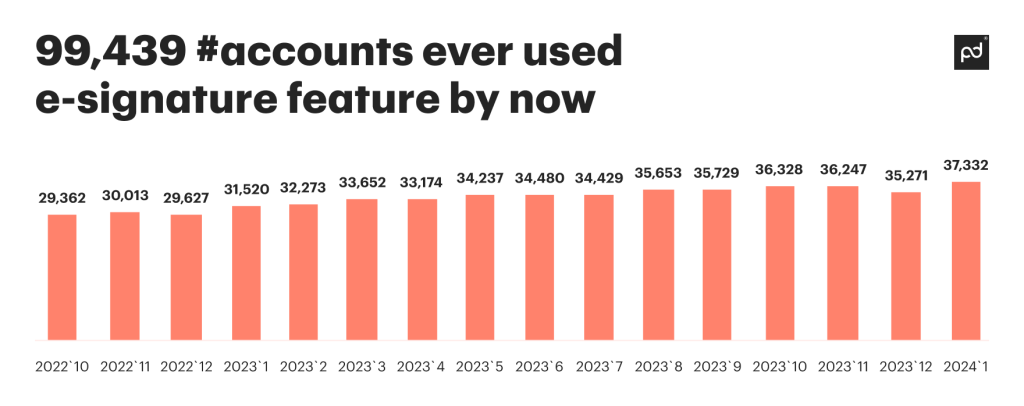
How to create a contract: Best practices
There are a few best practices you can follow that will help you make an effective contract.
1. Know your parties
It doesn’t get any easier than that—the parties are included in the opening paragraph of every contract you can think of.
Make sure to request this information from the other party before starting to work on the contract.
See also
Contract effective date vs. execution date: Understanding the difference
2. Agree on the terms
You must be as straightforward as possible from the moment you start writing your contract.
Not only will this make contract management easier in the future, but it will also mean that the contract is simpler to draft and understand.
This is why you should make sure that all parties agree on the terms of the contract before you start to draft.
If you need to bring the parties together to spell out an agreement physically, then do so.
However, for simple contracts, just receiving written intentions from each party should suffice.
3. Set clear boundaries
Let’s say that someone has agreed to wash your car.
They have just spent all day making it spotless, so does that mean that they’ve fulfilled their obligations?
Well, if the contract does not explicitly specify when the service starts and when it ends, they could argue that they never agreed on when they would stop washing your car and potentially refuse to leave your driveway.
Of course, this sort of exaggerated dispute is unlikely to occur in real life. Still, it’s very indicative of why it’s so important to specify an endpoint in the contract once you’ve outlined the principal agreement.
A lot of contracts are for ongoing work, but even those should include a termination clause—these clauses can also be used for parties to end a contract prematurely.
Finally, don’t forget to include a force majeure clause for situations that may be affected by circumstances beyond human control, and contract fulfillment becomes impossible.
See also
Contract tracking: An efficient method of monitoring a contract
4. Spell out the consequences
Contracts are an expression of good faith.
However, not everything always goes exactly to plan, so you need to manage contract risks right from the get-go.
Once you’ve drafted the agreement and specified the duration of the contract, you should outline the consequences for each party should they break the agreement.
These will depend on the type of contract that you’re producing.
In a rental agreement, for instance, you’ll need to include the consequences of a tenant failing to pay rent on time or damaging parts of the property.
Without these sorts of protections, the value of a contract becomes essentially worthless.
5. Specify how you will resolve disputes
Of course, simply including penalty clauses is not necessarily enough to manage these issues, as it’s always possible that the parties will disagree over failures to enact the agreement.
You should ask the different parties to agree to a method of dispute resolution, such as mediation, arbitration, or civil litigation.
Putting this into the contract will mean that any disputes will be fairly straightforward to resolve.
6. Cover confidentiality
Sometimes, the contents of a contract must be kept under wraps — for example, sections may include confidential information or trade secrets.
If this is your case, you must insert a confidentiality clause into the agreement.
Breaching this confidentiality would then itself be a breach of contract.
7. Check the legality of the contract
When you’re thinking about how to draw up a legally binding contract, you’re probably most concerned about producing a document that is legally enforceable and, whenever applicable, fully compliant.
To be certain that your contract is actually workable, you must make sure that nothing in it violates any applicable laws or local regulations.
(If you have any doubt, consider it a sign that it’s time to seek qualified legal advice.)
8. Open it up to negotiation
All of the above may seem like a lot of work.
Unfortunately, you might have to do it more than once!
Before a contract is signed, you should open it up to negotiation between the parties — it may take a while and with lots of back-and-forth, but it is likely worth the effort.
Tips for making your contract make sense
Now you know the step-by-step process of how to create a contract.
Follow these tips to make sure that your agreement makes sense:
Keep it simple
A legal agreement is not a space for boundless creativity and eloquence.
Overloading an agreement with wordy phrases and complex syntax will only make things more difficult, and you should also try to avoid jargon and legalese where possible.
Instead, use plain English throughout and remember who you’re writing for — not just the parties involved but also a potential litigator in the future.
In other words, don’t forget to keep every contract clause concise and to the point.
Watch out for modal verbs
Verbs like “may,” “shall,” and “will” need to be handled carefully when you’re drafting a contract.
“Shall” describes a compulsory action by a party — for instance, the tenant shall pay rent each month — while “will” is used for events that don’t require an obligation by a party.
Similarly, “may” is typically used as a way of saying “reserves the right.”
Avoid synonyms
Usually, we try to mix up our vocabulary when writing; however, it’s better to stick to the same words and phrases throughout a contract and avoid synonyms.
This will probably make you feel like your contract is repetitive — for example, you may get sick of using a word like “services” — but it will prevent confusion and ambiguity going forward.
Divide and conquer
You need to aim for ease and clarity when writing a contract.
Dividing the contract into multiple sections and subsections will help you simplify the agreement and improve its readability.
Try to avoid large blocks of text and use bullet points when possible.
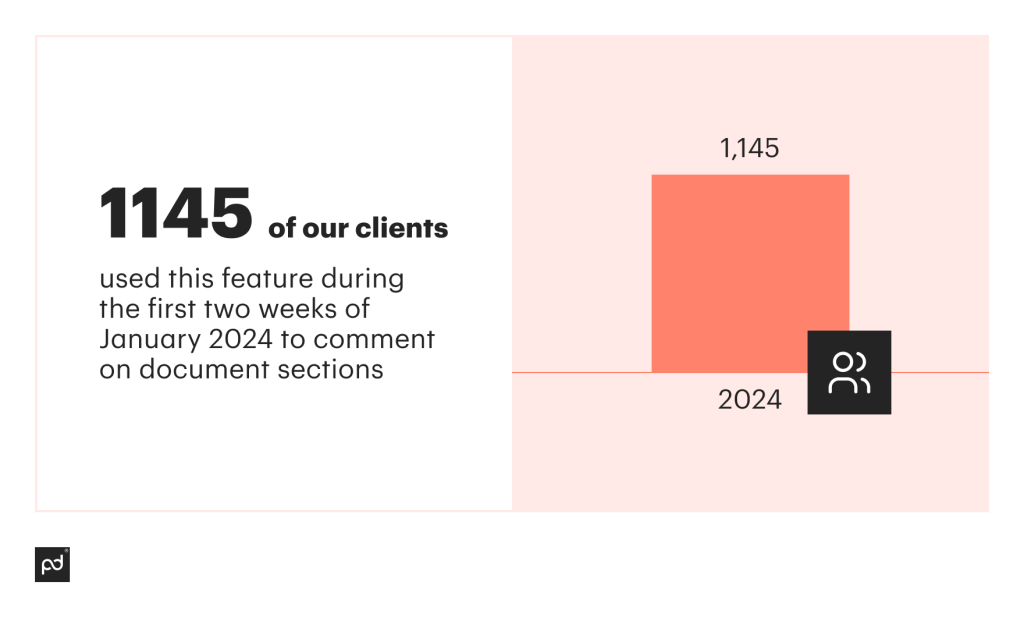
- Set out all requirements and responsibilities in plain English.
That includes payment schedules and penalty clauses. Keep the terms well-organized and easy to track.
- Finally, store and manage all your documents easily and securely.
Can I make my own contract?
Whether you’re creating a sales contract or service agreement, you can create one yourself and customize details, such as deliverables, the scope of work, and any warranties.
In fact, over 85,000 of our clients have counted on official contract templates to save time and minimize errors when crafting legal agreements — including 28,000 accounts during the first month of 2024.

Is a homemade contract legal?
A handwritten or self-created contract is legal, as long as it includes the necessary components and all parties agree.
We covered these above, but to summarize:
- Clear offer: One party must present a specific and unambiguous offer outlining the proposed terms and obligations.
- Mutual acceptance: The other party must agree to the offer, ideally in writing, to form a valid agreement.
- Exchange of value (consideration): Both parties must provide something of value—such as money, services, or promises—for the contract to be enforceable.
- Legal capacity: All parties must be of legal age, sound mind, and capable of understanding the agreement.
- Intent to create legal relations: Both sides must demonstrate a clear intention to enter a legally binding agreement.
Scale your business and make solid contracts with PandaDoc
As you scale, you may need to create hundreds of contracts every month.
Want more efficiency? Integrate tools with the solutions you use daily, such as CRMs, payment systems, or document storage solutions, and easily import data into your contracts.
With PandaDoc, you can create contracts in minutes, easily share and collaborate, automatically track renewals, and more. Contact us to schedule a personalized demo.
Frequently asked questions
-
Contracts clearly outline the responsibilities of all parties and provide legal protection if disputes arise.
-
Absolutely! With customizable templates and tools provided by platforms like PandaDoc, creating contracts is fast and easy. For complex agreements, consider consulting a lawyer.
-
A legally binding contract requires:
- Clearly identified parties
- Offer, acceptance, and mutual consent
- Consideration (something of value exchanged)
- Legal capacity of all parties
- Compliance with applicable laws
-
While verbal contracts can be enforceable, written agreements are highly recommended for clarity and easier dispute resolution.
-
Many contracts don’t require notarization to be legally binding, but notarization can add an extra layer of security by verifying the identities of the signers and confirming that they signed voluntarily.
This is especially common for specific agreements like real estate transactions or loan documents.
To notarize a document, you’ll need to visit a notary public in person or use an online notarization platform for convenience. Learn more about how to notarize a document online.
-
Keep it clear and concise, define key terms, include payment details and penalties, and ensure all parties review and sign.
-
Yes, eSignatures are recognized as legally valid in most jurisdictions and streamline the signing process.
-
Communicate openly, clearly outline terms, and use tools like inline comments to collaborate during drafting and revisions.
Disclaimer
PandaDoc is not a law firm, or a substitute for an attorney or law firm. This page is not intended to and does not provide legal advice. Should you have legal questions on the validity of e-signatures or digital signatures and the enforceability thereof, please consult with an attorney or law firm. Use of PandaDocs services are governed by our Terms of Use and Privacy Policy.
Originally published December 8, 2022, updated August 4, 2025
